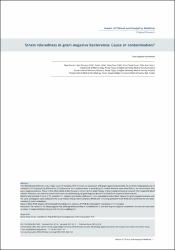| dc.contributor.author | Bahçeci, İlkay | |
| dc.contributor.author | Dilek, Aziz Ramazan | |
| dc.contributor.author | Şahin, Kazım | |
| dc.contributor.author | Yıldız, İlknur Esen | |
| dc.contributor.author | Duran, Ömer Faruk | |
| dc.contributor.author | Yazıcı, Zihni Açar | |
| dc.date.accessioned | 2022-08-07T12:18:17Z | |
| dc.date.available | 2022-08-07T12:18:17Z | |
| dc.date.issued | 2021 | en_US |
| dc.identifier.citation | Bahceci, I., Dilek, A.R., Sahin, K., Yildiz, I.E., Duran, O.F. & Yazici, Z.A. (2021). Strain relatedness in gram-negative bacteremia: Cause or contamination?. Annals of Clinical and Analytical Medicine, 12(8), 900-902. Doi : 10.4328/acam.20490 | en_US |
| dc.identifier.issn | 2667-663X | |
| dc.identifier.uri | https://onedrive.live.com/?authkey=%21AJ5i%2D3LUNXgm%2D7I&cid=A67EA0773797D3EC&id=A67EA0773797D3EC%214710&parId=A67EA0773797D3EC%214671&o=OneUp | |
| dc.identifier.uri | https://hdl.handle.net/11436/6302 | |
| dc.description.abstract | Aim: Bloodstream infections are a major cause of mortality, 25% of which are associated with gram-negative bacteremia. To avoid the inappropriate use of antibiotics, it is important to differentiate the bacteremia from contamination. In general, gram-positive bacteria were more likely to be contaminants than gram-negative-bacteria. There is little information in the literature concerning the epidemiology of gram-negative bacteria isolated from sequential blood cultures. Therefore, we aimed to examine the molecular epidemiology of gram-negative bacteria isolated from sequential blood cultures.
Material and Methods: A total of 56 patients (112 samples and strains) with two or more sequential positive blood cultures for gram-negative bacteria with the same antibiogram were included in the study. Pulsed-field gel electrophoresis (PFGE) and arbitrarily primed PCR (AP-PCR) were performed for the determination of strain relatedness.
Results: While PFGE analysis demonstrated relatedness in 6 isolates, AP-PCR demonstrated 9 relatedness in 112 isolates.
Discussion: The results of our study suggest that, although the possibility of contamination is very low in gram-negative bacteremia, this can still take place, as shown in sequential blood cultures with the same antibiogram | en_US |
| dc.language.iso | eng | en_US |
| dc.publisher | Bayrakol edical Publisher | en_US |
| dc.rights | info:eu-repo/semantics/openAccess | en_US |
| dc.subject | Bacteremia | en_US |
| dc.subject | Strain relatedness | en_US |
| dc.subject | Pulsed-field gel electrophoresis | en_US |
| dc.subject | Arbitrarily primed PCR | en_US |
| dc.title | Strain relatedness in gram-negative bacteremia: Cause or contamination? | en_US |
| dc.type | article | en_US |
| dc.contributor.department | RTEÜ, Tıp Fakültesi, Temel Tıp Bilimleri Bölümü | en_US |
| dc.contributor.institutionauthor | Bahçeci, İlkay | |
| dc.contributor.institutionauthor | Dilek, Aziz Ramazan | |
| dc.contributor.institutionauthor | Şahin, Kazım | |
| dc.contributor.institutionauthor | Yıldız, İlknur Esen | |
| dc.contributor.institutionauthor | Duran, Ömer Faruk | |
| dc.contributor.institutionauthor | Yazıcı, Zihni Açar | |
| dc.identifier.doi | 10.4328/ACAM.20490 | |
| dc.identifier.volume | 12 | en_US |
| dc.identifier.issue | 8 | en_US |
| dc.identifier.startpage | 900 | en_US |
| dc.identifier.endpage | 902 | en_US |
| dc.relation.journal | Annals of Clinical and Analytical Medicine | en_US |
| dc.relation.publicationcategory | Makale - Uluslararası Hakemli Dergi - Kurum Öğretim Elemanı | en_US |


















